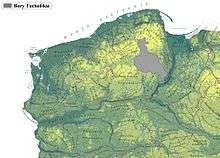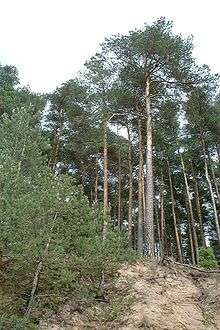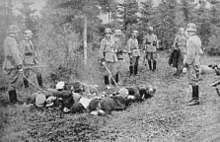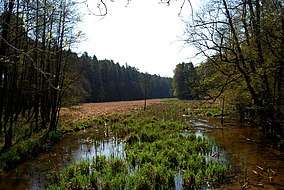Tuchola Forest
The Tuchola Forest, also known as Tuchola Pinewoods, (literal translation of Polish: Bory Tucholskie; Kashubian: Tëchòlsczé Bòrë; German: Tuchler or Tucheler Heide) is a large forest near the town of Tuchola in northern Poland, which lies between the Brda and Wda Rivers, within the Gdańsk Pomerania region. It contains the Tuchola Forest National Park, which is at the core of the Tuchola Forest Biosphere Reserve, designated by UNESCO in 2010.

.jpg)

Landscape
The area was formed during the last glacial age and is covered with low hills and more than 900 post-glacial lakes. With 3,200 km² of dense spruce and pine forest, the area is one of the biggest forests in Poland and Central Europe. Since 1996, part of the area has been designated as the Tuchola Forest National Park, covering 46.13 square kilometres (17.81 sq mi). Approximately 30% of the area is inhabited by the Kociewiacy people.
History
It formed part of Poland since the establishment of the state in the 11th century. After the First Partition of Poland in 1772 the area was annexed by Prussia, and from 1871 it was part of the German Empire. Under German rule, near the village of Grupa, a military exercise area Truppenübungsplatz Gruppe was established, in which medical research was conducted, leading to publication of the name in scientific reports of the early 20th century. During World War I, pacifist doctor Georg Friedrich Nicolai was banished from Berlin to the remote area which had to be restored in 1919 to Poland as a result of the Treaty of Versailles, after Poland regained independence in November 1918.

In 1939, during the invasion of Poland at the very beginning of World War II, the major Battle of Tuchola Forest was fought in the area. Soon, the former military test area was occupied again by German troops,[1] and called Truppenübungsplatz Westpreußen, or by its code name, "Heidekraut". During the occupation, in October and November 1939, Germans murdered 335 Poles from Tuchola and Tuchola County in six large massacres in Rudzki Most.[2] Among the victims were teachers, school principals, merchants, craftsmen, farmers, priests, foresters, postmen, railwaymen, policemen and local officials, including mayor of Tuchola Stanisław Saganowski.[3]
Between August 1944 and January 1945, SS troops under Hans Kammler and Walter Dornberger carried out extensive tests of the A-4 missiles (V-2 rockets),[4] after the test site near Blizna was discovered by the Home Army and then bombed by the Allies. Approximately 107 missiles were fired in a southbound direction for tests and training purposes. In January 1945 the site had to be evacuated before the Red Army offensive overran the area.
After World War II, the forest was a safe haven for many anti-communist partisans, among them Zygmunt Szendzielarz.
Biosphere Reserve

In June 2010 the Tuchola Forest area was designated by UNESCO as a Biosphere Reserve. The core area of the Biosphere Reserve consists of Tuchola Forest National Park and of the 25 nature reserves lying within the buffer zone. The buffer zone consists of Tuchola, Wda, Wdzydze and Zaborski Landscape Parks. There is also a transit zone which includes the town of Tuchola and surrounding districts. The core area of the Reserve covers 78.81 square kilometres (30.43 sq mi), and the three zones together cover 3,195 square kilometres (1,234 sq mi).[5]
Population
The Borowiacy (or Borowiacy Tucholscy) are a Polish ethnographic group who traditionally inhabit this area. They live next to the other notable ethnographic groups of Gdańsk Pomerania, the Kashubians and Kociewiacy.
See also
- List of V-2 test launches
- Rocket launch site
References
- Heinz Guderian: Erinnerungen eines Soldaten, "Ich hatte am 3.9 ... meinen Sohn Kurt wiedergesehen und mich dabei an den Türmen von Kulm, meiner Geburtsstadt, erfreut, die vom Ostufer der Weichsel herüberwinkten. Am 4.9 ... bei ihren Waldgefechten und endete auf dem alten deutschen Truppenübungsplatz Gruppe westlich Graudenz.", 1951,
- Maria Wardzyńska, Był rok 1939. Operacja niemieckiej policji bezpieczeństwa w Polsce. Intelligenzaktion, IPN, Warszawa, 2009, p. 169 (in Polish)
- Wardzyńska, p. 170-171
- Dornberger, Walter (1954). V-2. New York: The Viking Press, Inc. p. 211-214.
- Website of Tuchola Forest Biosphere Reserve
- (in German) Erich Wernicke: Wanderungen durch die Tuchler Heide. Kafemann, Danzig 1913 (Digitalisat)